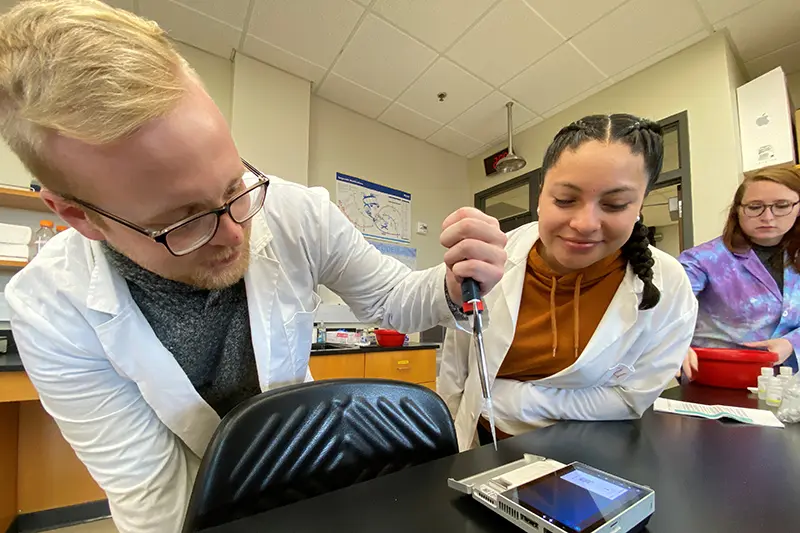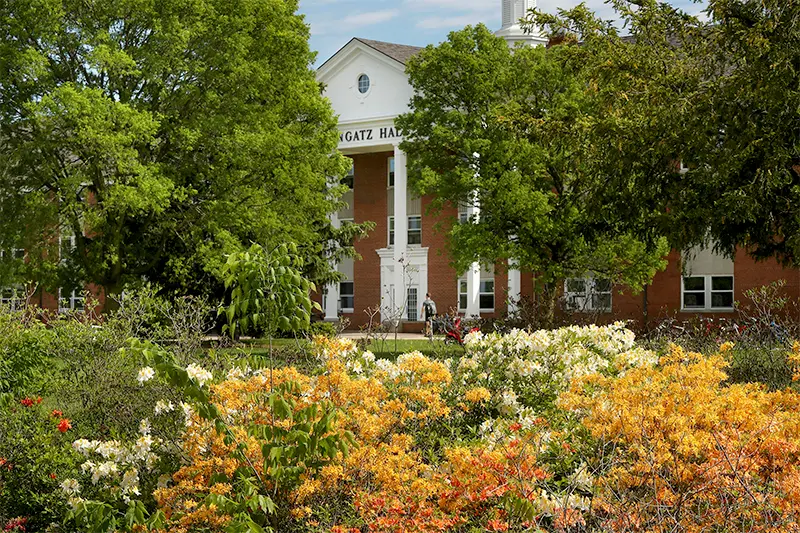-
-
- Financial Aid
- Financial Aid
- Scholarships
- Loans
- Grants
- Federal Work Study
- Additional Resources
-

At Taylor, the pursuit of learning is important for every person on campus, not just students. Faculty on campus perform research in their pursuit of learning with the goal of contributing to new developments in their field.
Professor Elizabeth Hasenmyer and Dr. Sarah Justice, Assistant Professors of Biology, are collaborating to give students firsthand experience with DNA sequencing. They have recently secured funding to buy a DNA sequencer, which will give students the ability to work directly with state-of-the-art technology while conducting novel research.
Here’s a quick primer on DNA sequencing: DNA is made of four nucleotide bases (adenine, cytosine, guanine, and thymine) that create a four-letter alphabet: A, C, G, and T. DNA sequencing technologies allow us to take DNA from an organism and determine the exact order of these four bases to determine the genetic code. DNA sequencing has had a profound impact on medicine, forensics, and agriculture, and knowledge of species’ genomes continues to grow.
“DNA sequencing has allowed for exciting new discoveries in the biological sciences,” said Justice. “Because the research has become more widespread, having a DNA sequencer is within reach for us at Taylor; it’s very exciting that our students will be able to use this as part of their studies on a regular basis.”

Currently, the classes and research groups that utilize DNA sequencing pay to have samples analyzed offsite. Now, this step of the research process will be possible in a lab in Euler Science Complex.
Visitors to Taylor’s campus in May and June might notice the profusion of pink, yellow, orange, and white azaleas nestled in the area around the creek flowing from Euler Science Complex to the Memorial Prayer Chapel.

Azaleas are a popular ornamental flowering shrub commonly planted in yards across the world. While those planted on campus are native to North America, those most widely cultivated for purchase in the United States are Chinese varieties. The genome for some of the Chinese azalea species has been mapped and studied, but very little research has been conducted on North American varieties.
North American azaleas tend to be found in remote regions of the Appalachian Mountains, making them more difficult to study. Taylor’s garden of native North American azaleas was planted over a decade ago by professor emeritus Dr. Andrew Whipple in an effort to make these plants more easily accessible for research.

Now, with the use of Taylor’s new DNA sequencer, students and faculty can experience the research project from start to finish: field work, DNA extraction, sequencing, analyzing the data, and communicating the data.
Justice utilized proteomics and transcriptomics in pursuit of her doctorate. She came to Taylor after completing her PhD and now teaches in the Biology department. She, along with students in her research group, continues to analyze data acquired during her graduate studies. In addition, Dr. Justice collaborates on genomics projects with the Genomics Education Partnership, a group made up of over 275 faculty at universities across the country. Undergraduate students contribute to this project by annotating genes in newly sequenced species of Drosphila (fruit fly).
Genes are made of individual letter expressions that the cells in the body interpret. Scientists are currently trying to understand which arrangements of letters code for various genetic expressions. This has been an on-going national project, and Justice and her team of students have been contributing to the results of that research.
“We actually have to take all those letters and identify the anatomy of a gene,” Justice said. “What we're doing is we're taking the seemingly “gibberish” DNA sequences and figuring out which ones are the ones that actually make protein.”
Knowing what genes code for what proteins helps scientists and medical professionals understand the human body and how best to care for it.
At Taylor, the investigation of science is an expression of faith and glory of God’s design. Justice and Hasenmyer believe this wholeheartedly.
“I was saved during my senior year of high school and I started my official scientific training my freshman year of college,” Justice said. “So [faith and science] have always gone side by side together. It’s been a path where I became a Christian, and am growing as a Christian, and becoming a scientist, hand in hand.”
Hasenmyer sees learning as an act of worship, and wants to help her students see the wonder of God’s creation in their research work.
“Creation is God’s general revelation to us,” she said. “It’s something God gave us, and He gave us the intellect to strive to understand it.”
Ready to flex your God-given desire to learn more about the world around us? Taylor’s Biology Program has three majors: Biology Investigations & Applications, Biology Health Sciences, and Biology Science Education. Contact us to schedule your campus visit.
A grant from the Women's Giving Circle made it possible for Justice and Hasenmyer to purchase the DNA sequencer. The Women's Giving Circle is a welcoming circle of women who combine their resources to support the Taylor Fund, strengthen Taylor academic departments, and impact students through funding innovative projects and opportunities.